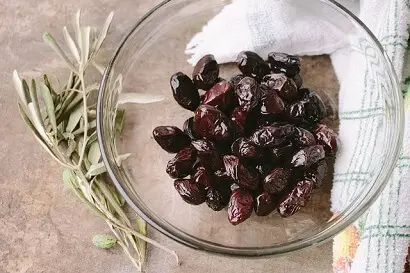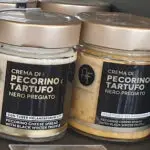You’ve probably seen them on the shelves at the grocery store or mentioned on charcuterie board recipes, but what actually sets Kalamata olives apart from the much cheaper options? Why are Kalamata olives so expensive?

Kalamata olives are more expensive because of their size, meaty texture, and desirable flavor. They are generally eaten as table olives and require a relatively costly growing, harvesting, preserving, and shipping process.
Read ahead to find out all about this famous kind of olive, where they come from, and what exactly gives them the higher price tag in the store.
What Does Kalamata Mean?
To understand the price of a Kalamata olive, we first need to understand what the name actually means. They get their name from the city of Kalamata in Greece, around which they were first grown.
Within the EU, the name “Kalamata Olives” has PDO status, which stands for “Protected Designation of Origin”. This means that only olives actually grown in the Kalamata region can be labeled as such. Therefore, Kalamata olives in the EU will always have a higher price tag as they can’t be grown elsewhere to increase the supply and reduce shipping costs.
In other parts of the world, however, the name is not protected and simply refers to the olive variety, regardless of where they were farmed.
What Makes Kalamata Olives Different?
Wherever in the world you buy them, Kalamata olives are a specific type of large, dark brown olive that has become highly sought-after due to their unique qualities. They are bigger than cheaper black olives, they have a smoother, meatier texture, and they have a distinct and very delicious flavor.
They are most often eaten on their own rather than cooked into a dish, and they are usually preserved in wine vinegar or olive oil to give them the best possible texture and flavor. These preservation methods are more expensive than using brine or drying, which adds to their cost.
You won’t often find these olives packaged in large quantities for mass consumption. Rather than big jars full of olives to throw into a stew, they come in smaller portions that are designed to be savored and are therefore more expensive to buy.
Growing Kalamata Olives
Besides their notoriety and prestige, the high price tag on Kalamata olives also comes as a result of how difficult they are to grow, farm, and transport. While black olives are now grown all over the world, some varieties require more specific conditions than others, are more vulnerable to sickness, and are harder to harvest.
Some Kalamata olives are harvested in places like Australia and the United States, but they are very intolerant of cold weather and susceptible to disease. They also cannot be harvested while they are still young and green and have to be hand-picked because of how easily they bruise.
Of course, these factors combined mean that it costs significantly more money to grow, care for, harvest, and ship Kalamata olives than other varieties, and there is more risk of the trees failing and needing to be replanted.
Other Famous Olives
Kalamata olives are far from the only well-known and highly-regarded olive variety on the market. In fact, there are many different names in the olive industry that come with a pedigree and a large price tag.
Some of the most famous types of olives include:
- Thassos. Greek olives with wrinkly skin cured in salt.
- Cerignola. Large green Italian olives that are cured in brine and slightly citrusy to taste.
- Arbequina. Bitter Spanish olives that are cured in brine, and come in a variety of colors.
- Niçoise. Famously a key ingredient in the salad of the same name, these are small French black olives with a strong flavor.
- Nyons. Tender black olives from France that are slightly bitter.
- Gordal. Big and juicy Spanish green olives, rich to taste and meaty.
- Castelvetrano. Bright green and sweet olives from Sicily, Italy; favorite for snacking.
- Gaeta. These Italian olives are small and almost purple with a tart flavor.
There are actually more than 100 different varieties of olive that are regularly grown around the world, which means there is an olive for every occasion and every mood. Some are much more popular and respected than others, and many that you will find being sold in the store won’t even tell you their variety at all.
Why Are Some Black Olives So Cheap?
While Kalamata olives are certainly pretty expensive, there are many options for very low-cost black olives on the market, so why are these so much cheaper?
Many of the cheapest black olives that you will find in the United States, in particular, are known as “California Black Olives”. This term doesn’t refer to the variety that is used or where they are grown, it actually refers to the way that they are processed. In some ways, they are not really black olives at all.
All olives grow green when they are “unripe”. Olives naturally turn black as they ripen, but this takes quite a long time, and the olives themselves become tender and difficult to harvest and ship without bruising – which is true of the Kalamata variety.
California black olives are actually green olives that have been cured in a special alkaline solution and then treated with oxygen to turn their skins and flesh black. This process is cheaper and easier to carry out on a large scale than ripening the olives naturally, and it is why they have such a different flavor and texture from “true” black olives.
Summary: Why Are Kalamata Olives Expensive?
Kalamata olives are expensive because they are a variety that is appreciated for their size, texture, and flavor. They are also more difficult and expensive to grow, harvest, and ship than the much cheaper “California black olive”.
In the EU, Kalamata olives have to be grown in the Kalamata region of Greece to be given that name, but there are some producers of Kalamata olives elsewhere in the world as well, including in the United States.
- The Top Restaurants Specializing in Truffle Dishes - August 10, 2023
- Truffle Panna Cotta: A Decadent Dessert Recipe for Truffle Lovers - August 7, 2023
- Truffle Scrambled Eggs: A Luxurious Breakfast Delight - August 7, 2023








